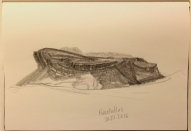Í framhaldi af síðasta pósti er ekki úr vegi að nefna yfirlitssýninguna á Kjarvalsstöðum (Jóhannes S. Kjarval: Hugur og heimur) sem á um það bil mánuð eftir. Sérstaklega er gaman að sjá verkin úr safni Þorvaldar og Ingibjargar sem eru í vestursalnum.
Áhugavert hvað Vífilsfellið kemur víða fyrir í þessum verkum. Ákveðin tenging þar við yfirskrift sýningarinnar því Kjarval setti gjarnan inn í verk sín einhvern útgangspunkt í heiminum þótt maður skynji glöggt að það sem hann er raunverulega að fást við í verkinu sé af öðrum toga, fantasía eða abstraksjón. Þessi útgangspunktur (eða inngangspunktur) er örugglega stundum tilkominn í þágu áhorfandans en ég er á því að oftast spretti hann af nálgun og vilja til þess að ná samruna og einingu – að hugur og heimur séu eitt.
Þannig vil ég líta svo á að Vífilsfellið þjóni ekki þeim tilgangi að vera bakgrunnur eða leiksvið fyrir konurnar í álfaheiminum (í dýrðlegri mynd frá 1938) heldur lýsi einfaldlega þeirri staðreynd að hugsýn hlýtur alltaf að eiga sér stað – getur raunverulega ekki án staðar verið.
En tvíhyggjan er lífseig og sú hugsun að allt hljóti ævinlega að vera „annað hvort eða“. Þótt yfirskrift sýningarinnar segi vissulega hugur og heimur, er stutt í að við dettum í gamla farið og förum að flokka: þetta er landslagsmynd og þetta er fantasía; hér er karlinn að rýna í hraunið og hér er hann að horfa til fjalla. Horfa inn – horfa út.
Í raun erum við svo skilyrt af þessum aldagamla Platónska arfi að við eigum erfitt með að sjá eininguna í gangverkinu. Og að tilgangur þarf ekki endilega að vera mannmiðaður þótt okkur sé svo óendanlega tamt að líta svo á.
En þetta eru heimspekilegir útúrdúrar sem draga athyglina frá mergi máls sem er að Vífilsfellið er með skemmtilegri fjöllum að fást við því sjónarhornin eru mörg og fjölbreytt og ásýndin mjög mismunandi eftir árstíðum. Fjallið á sér marga vini og því kemur ekki á óvart að flestir vilji sjá það sem borgarfjall Kópavogs. Það væri laglegt.

- Vífilsfellið akvarella 25×37 2015 // Mt. Vífilsfell aquarelle 25×37 2015
// It follows from the previous post to mention the extensive exhibition of the work of Jóhannes S. Kjarval “Mind and World“that is currently running in both galleries of Kjarvalsstaðir (until 21 August). The west gallery exhibits works from the collection of Þorvaldur Guðmundsson and Ingibjörg Guðmundsdóttir and many of those merit special attention.
It is interesting to see that Mount Vífilsfell is portrayed in many of the works. This connects in a way to the epigraph “Mind and World” as Kjarval frequently inserted in his works a worldly point of reference although one can easily discern that he is preoccupied with things of a different nature, fantasies and abstractions of sorts. This point of reference (be it for departure or arrival) is no doubt sometimes intended to facilitate the beholder, but to me it is clear that very often the point of the point (or so to speak) is to convey an approach – and a will – towards synthesis and unity. That Mind and World are indeed one.
Viewed in this manner Mount Vífilsfell does not serve the purpose of being a backdrop or stage for the elven maidens (in a glorious painting from 1938), but rather as a statement of fact, that the fantasy will always have a place – indeed that it cannot be without a place.
But dualism is a persistent phenomenon and the thought that everything must essentially be “this or that”. Even though the epigraph certainly allows for unity (“Mind and World”) the seeds are sown and instantly we start to categorise: this is a landscape and this is a fantasy. Here Kjarval is painting the lava and here he is looking towards the mountains. Now looking in – now out.
The thought is essentially so conditioned by the age-old Platonic heritage that we overlook the harmonious unity in the machine. And that purpose is not necessarily a anthropomorphic concept although we are seemingly stuck with that notion.
But these are philosophical ramblings which completely overlook the essential thing, that it is very giving to portray Mount Vífilsfell , as the possible views are so many and varying and its looks very different all in accordance with the seasons.

- Skissur 10. ágúst 2013, 18. maí og 17. júní 2016 // Sketches 10 August 2013, 18 May and 17 June 2016














